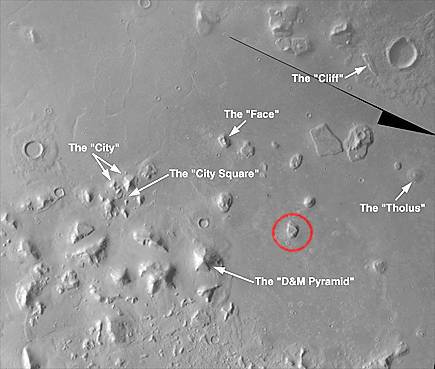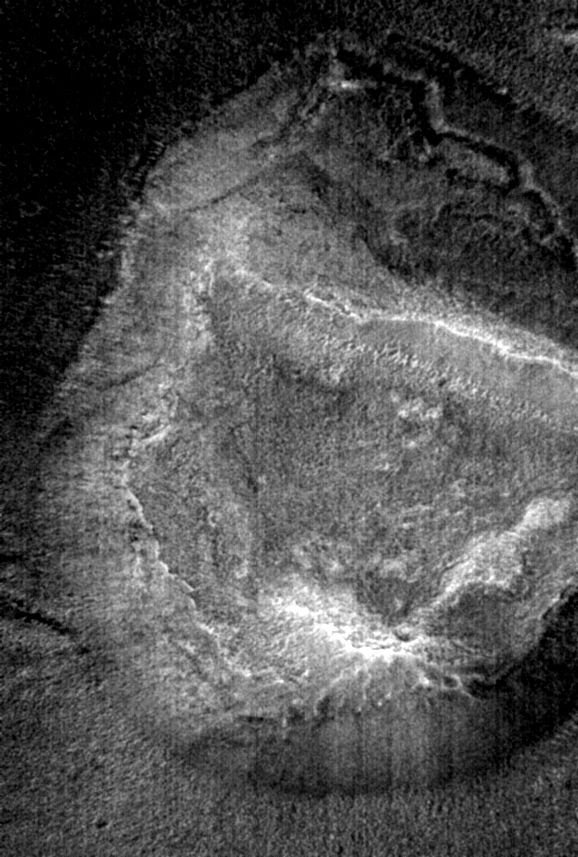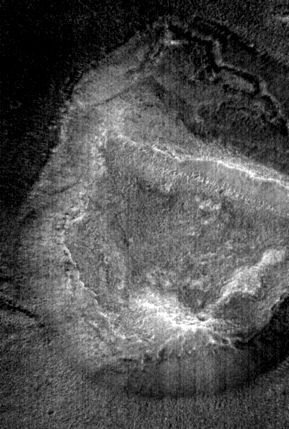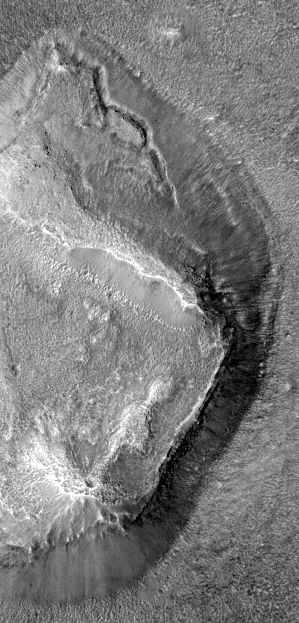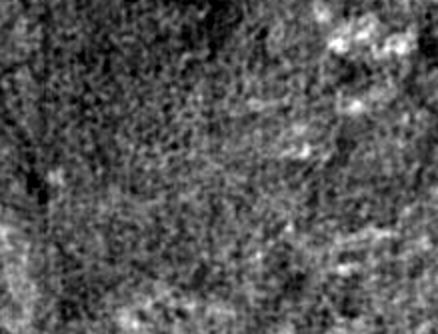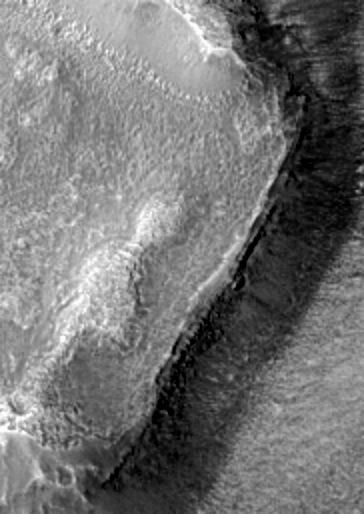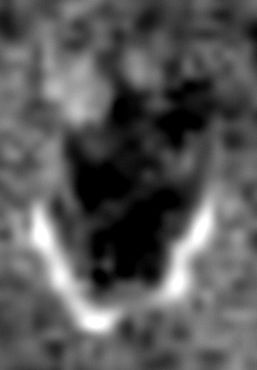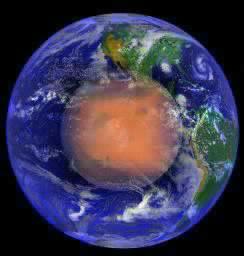 Cydonia Quest C Image Enhancements C The Collapsed Mesa The "Collapsed Mesa" is another example of a formation at Cydonia that exhibits the strange phenomena of "inside out" erosion. In other words it appears to be collapsing into its own interior as if it had a honeycombed internal structure. The location of the "Collapsed Mesa" is circled in red in the context image below which names the more famous Cydonia anomalies. |
| C ccccccccccccccccccc C The strange appearance of the "Collapsed" Mesa was noted by others when an extremely "dirty" and "noisy" Mars Global Surveyor image of its western side was released in April 2000. (Just how poor the image released to the public is can be seen by clicking on the next "stargate" µµµ). The picture was taken at the lower end of MGS's imaging resolution, which compounds the difficulties of finding evidence of artificial structure. In the full resolution, enhanced version of this image below, it can be seen that what appears to have originally been a flat topped formation has suffered an inward collapse in its central region leaving "ramparts" around the edge. C ccccccccc
C Readers will find it easier to view the above image in its entirety if they use the "View" and then "Full Screen" options on their browser tool bar. Since this image was taken MGS has imaged the eastern side of the "Collapsed" Mesa. Although this second image is clearer it is at the very lowest end of the range of MGS's resolution capabilities. This second image is shown at full resolution (below right) and compared with a reduced version of the first image of the western side. It is immediately apparent how straight the northern and eastern ramparts of the "Collapsed Mesa" are - especially the eastern one. It is therefore tempting to consider that what we are looking at is the remains of an artificial structure - a super building, namely an arcology. C
C Both of the MGS images appear to show that the interior of the proposed region of collapse is filled with jagged rubble, which is what we would expect if the roof and upper layers of a honeycombed structure had collapsed. The image below left shows part of the floor of the interior enlarged by a factor of two to show what appear to be mounds of rubble. The image below that is a two times enlargement of the eastern rampart illustrating how straight and parallel it is with the base of the "Collapsed Mesa". C cccccccccccccccccccccc ccccccccccccccccccccccccccc C The material for this article was prepared several months ago last Autumn, but was put to one side whilst a series of articles on the first set of daytime infra-red (IR) images of Cydonia, taken by the Mars Odyssey, was prepared. In the interim the first night-time IR image of Cydonia has been released (see µµµ). This was extremely noisy, but it did reveal that the "Collapsed Mesa" is an extraordinary object. The night-time IR image revealed that the outer western, southern and eastern walls of the "Collapsed Mesa" were some of the warmest features in the image. However, the collapsed interior contained what were just about the coldest areas covered by the image. This can be seen in the enlarged and noise reduced night-time IR image of the "Collapsed Mesa" below. C cccccccccccccccccccccccccccccccccc
C The interior of the collapsed area is in sunshine for most of the day, so there is no question of it not receiving enough heat to warm up in the first place. Many slopes elsewhere in the night-time IR image that are in heavy shadow for the last part of the day were still warm. There are three possible explanations for why the interior region of the "Collapsed Mesa" cooled down so quickly. None of them are mutually exclusive and all could be true. Firstly, the rubble that seems to be within the collapsed interior is very loosely packed, so it quickly radiates away its heat early during the night because it is poorly insulated. Secondly, the rubble may be made of a different material that gives heat away much more quickly than the material that makes up the outer walls of the "Collapsed Mesa". The third possibility is a much more overtly artificial explanation. This is that only a top layer of honeycombing in the "Collapsed Mesa" has caved-in and that there are levels of honeycombing below the rubble layer that remain intact. During the night the rubble layer radiates heat away quickly into the poorly insulated honeycomb below and not just up into the Martian sky. (It is assumed that the interior honeycomb contains a near vacuum like the external environment). What would be helpful in determining the artificiality or otherwise of the "Collapsed Mesa" would be an MGS image across this formation at the highest resolution available of 1.4 metres per pixel. This may help reveal whether there is a geometrical nature to the rubble fragments that fill the interior. C µ Return to the Enhancements page µ Return to the main Mars page µ Return to the Cydonia Quest main page
|
